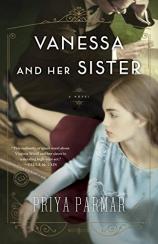Vanessa and Her Sister
Review
Vanessa and Her Sister
Priya Parmar’s second novel (following EXIT THE ACTRESS) explores the lives of two young women who one day would gain great fame. The elder, Vanessa Stephen, is the narrator of her life with her sister, Virginia, from 1905 to 1910 during the emergence of the Edwardian era. The two would later marry and become artist Vanessa Bell and her more famous sibling, Virginia Woolf.
However, at this point in their lives, they are single young women, home-educated by their aristocratic parents and considered spinsters by Victorian standards. With that stringent era recently behind them, arts and literature are undergoing a revival that will underpin not only the changing public artistic tastes, but also the more relaxed moral behavior among this generation. Single women are enjoying liberation from the strict constraints of the recent past, and marriage is no longer the only option for women of independent means. The homosexuality of some of the characters is openly accepted, despite the not-so-distant imprisonment of another intellectual, Oscar Wilde. Even open marriages are becoming publicly acknowledged.
"Parmar uses letters, telegrams and Vanessa’s diary entries to create an intriguingly original novel that details the day-to-day activities, travels, romances and, sadly, medical ailments that regularly plague the main characters."
Vanessa and Virginia, along with their two brothers, Thoby and Adrian, live together in the fashionable Bloomsbury district of London in their stately family mansion on Gordon Square. The boys begin hosting regular Thursday night salons engaging their Cambridge-educated male friends in a wide-ranging exploration of arts and literature. The food and alcohol flow freely with the intellectual discussions in which the sisters are actively welcomed to engage. Among the regular attendees are young students and graduates of fashionable English universities who would later join a pantheon of famous thinkers, writers and artists, such as E. M. Forster (fondly referred to as The Mole), renowned economist John Maynard Keynes, and artists Lytton Strachey and Henry Lamb. Vanessa eventually extends the salons to Friday night soirees to include artists from her circle of acquaintances until the two gatherings run into weekend events.
Parmar uses letters, telegrams and Vanessa’s diary entries to create an intriguingly original novel that details the day-to-day activities, travels, romances and, sadly, medical ailments that regularly plague the main characters. Vanessa repeatedly rebuffs Clive Bell’s ardent pursuit for marriage, which eventually leads to an unhappy union, while Virginia seems to live in a troubled and reclusive world of her own. She retires to her quarters to pen essays and articles for London-based publications, dabbles in ideas for a novel, and occasionally attends the salons, but seems content to exist on the fringes of her siblings’ activities. Her bouts of “madness” are taken for granted among friends and family, even when she is confined by her doctors on more than one occasion for “the rest cure.”
The Bloomsbury Group and many of its participants have long been subjects of literature, movies and the objects of speculation. Not only has Parmar brilliantly captured the essence of an era of intellectual exploration, she also has breathed life into several of its larger-than-life characters.
Reviewed by Roz Shea on January 8, 2015
Vanessa and Her Sister
- Publication Date: October 13, 2015
- Genres: Fiction, Historical Fiction
- Paperback: 384 pages
- Publisher: Ballantine Books
- ISBN-10: 0804176396
- ISBN-13: 9780804176392





